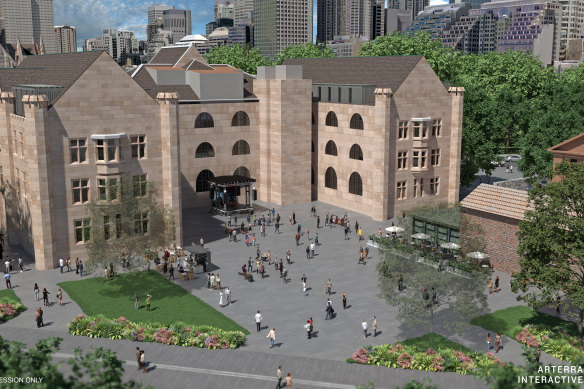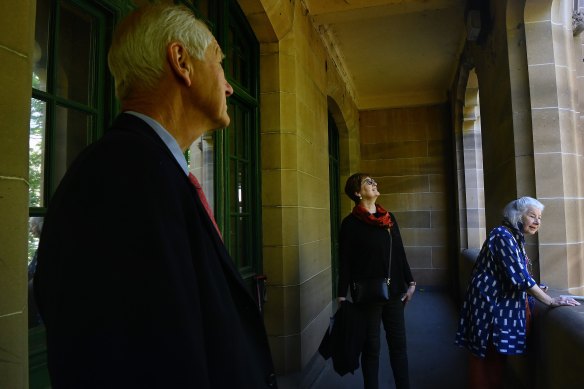Save articles for later
Add articles to your saved list and come back to them any time.
Demolition works have begun to return one of Sydney’s most prominent historic sandstone buildings to its former glory while paving the way for a new public square dedicated to the late Queen Elizabeth II.
Once the repository of the births, deaths, marriages, and land titles of every NSW citizen, the old Registrar General’s building has lain empty for most of the past three years.
Public space will be restored to the curtilage of the old Registrar General’s building from next October.
But bulldozers have now moved in to pull down its modernist additions behind Macquarie Street – a northern extension, built in 1956, and the 1963 Records Annexe, designed by Sydney Opera House architect Peter Hall.
These changes are deemed necessary to restore the 1913 neo-gothic building to its original design and open up access to its curtilage and the wider historic precinct. Buckingham Palace has been consulted on the design of a new public square – to be named Queen Elizabeth II Place – that will be created from the footprint of the demolished blocks at the rear of the Hyde Park Barracks.
There is even speculation that King Charles’s next royal visit, timed for the Bicentenary of the NSW Legislative Council in 2024, will include an official dedication of the memorial place. But the government is said to be keen to find more contemporary and interpretive ways to mark history within the new public space – other than a single bronze bust of the late monarch.
First Nations histories are to feature in the new public space behind the Hyde Park Barracks. And there will be a heritage interpretation of the felled mid-20th century additions – including the Peter Hall annexe, which was the first non-residential building to use clinker bricks.
Descendants of designer Walter Liberty Vernon couldn’t be more delighted with the plans to restore public views to the wedding cake building and its unique U-shaped form and fabric. A plaque was unveiled on Monday at the building’s entrance in recognition of Vernon’s contributions as NSW Government Architect from 1890 to 1911.
Vernon designed the former Land Titles office in 1908, six years after the opening of the Art Gallery of NSW, and together they represent two of his crowning architectural achievements among a vast portfolio of public buildings.
The descendants of architect Walter Liberty Vernon, Michael Vernon (left), Katharine Vernon (centre) and Jane Vernon (right) tour the Registrar General’s building in Sydney. Credit: Kate Geraghty
Great-granddaughter Jane Vernon said the architect had regarded public buildings as monuments to the arts, to be large in scale and finely wrought in stone.
“It’s wonderful the government is trying to bring the building back to its original format, shall we say, opening up the area,” brother Michael said.
The building works represent the first major milestone to transform Macquarie Street into Sydney’s version of London’s Museum Mile.
Former Prime Minister Paul Keating and former Greater Sydney Commission Chief Commissioner Lucy Turnbull reviewed the use of the area and found in 2018 that the precinct lacked vibrancy.
Some $120 million has been set aside to transform the eastern side of Macquarie Street and its collection of heritage buildings over the next 20 years into a civic boulevard that prioritises people, arts and culture.
The project works at Macquarie Street’s southern tip are expected to be complete by October 2024, but future uses of the building are still to be announced.
Given the demolition works, Independent MP Alex Greenwich said it was important the Registrar General’s building find a new lease of life as a gallery, museum or public meeting area.
“If we’re able to create a public square, to have that connectivity between Macquarie Street and the parklands of the Domain, then that is a community gain,” he said.
“If, as a result [of demolition], buildings like the Registrar General’s building flourish and open up and the public have greater access to it, then these things make sense.”
Hall’s son Willy said the demolition of the annex did not sit well with him, being one of the better examples of his father’s early work, but he was resigned to the fact that it was for a greater good.
During his time as NSW premier, Dominic Perrottet had championed a $9 million business case to convert the building into a museum dedicated to presenting the state’s First Nations, colonial and migrant history.
Offices of the rebranded Museums of History would be relocated from The Mint to basement floors beneath the Peter Hall annex, which are protected by a half-metre slab of concrete and are to be kept intact after the above-ground annex floors have been removed.
A cheaper alternative is to repurpose the inactive ground floor and basement for cultural, retail, and dining purposes.
In granting approval for the demolition works last November, the NSW Heritage Council obtained assurances from Property and Development NSW that the building’s upper levels would be activated regardless of the political fate of the proposed new Museum of History.
The Booklist is a weekly newsletter for book lovers from books editor Jason Steger. Get it delivered every Friday.
Most Viewed in Culture
From our partners
Source: Read Full Article




